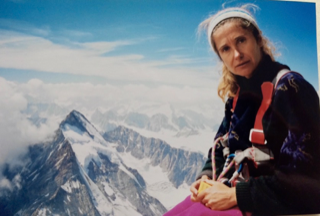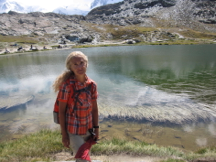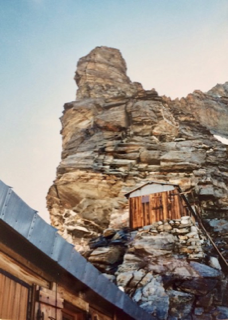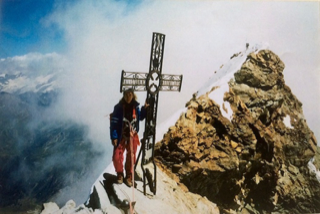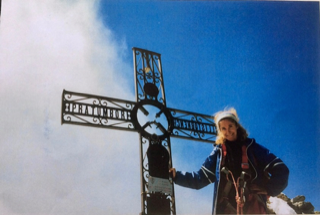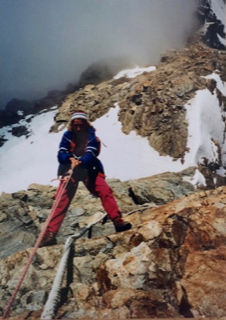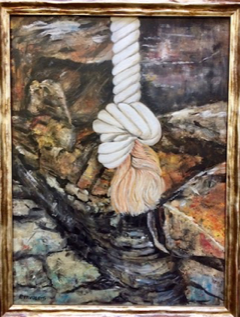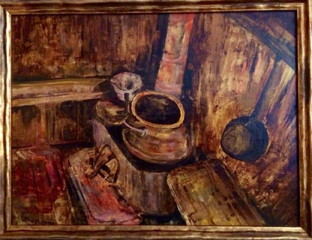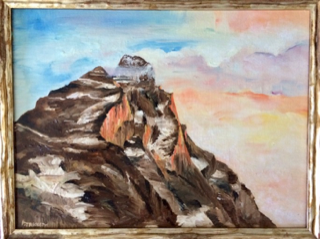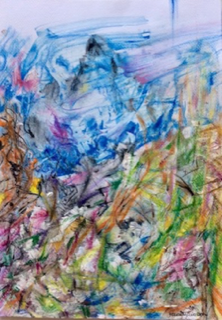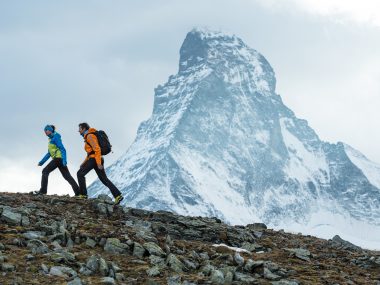The other side of the mountain of my dreams
Paola Tavoletti, a regular hiker in Zermatt and an artist and illustrator and Matterhorn climber.
“… It has been like flying in the sky.
My body on the rock at 4476 meters altitude, tenacious and suffered gestures so long imagined, the thirst, the dizziness, the emptiness, the glaciers and stone pinnacles extending as far as the eye can see, the sound of carabiners, the silence of the air, the scream of the last black birds, outside and inside the clouds all around. Cross on top, handprints of each of us on your metal, to how many of us you belong in our hearts. A brave, liberating, poignant dance on the wall on the cold stone of the hours of dawn. Slow dawn of splendor … you invade the world, and here from the mountain of my dreams you are as clear as crystal water, a clear waterfall that cleaves its dark sides. Sunset of fire and rock torn by the violet blue of the sky steals the sight of these August hours, my hours on the Matterhorn.…It has been like flying in the sky.”
(Paola Tavoletti – from ’Sarà ancora mattino’ , Robin Edizioni 2003 Rome)
What drives a human being to try to climb a giant like the Matterhorn?
For me it has been the passion for mountains and also the desire to emulate Gigi Tavoletti, my father. He had climbed the Cervino, the Italian name for the Matterhorn, along the Cresta del Leone – the Italian south west ridge or Lion Ridge – with only a rope tied at his waist, as harnesses did not exist at those times! And, he had climbed and descended the Matterhorn, with his alpine guide, in only one day, from Cervinia.
8 hours without stopping
When I decided to hire an alpine guide to repeat his adventure, in the august of 1995, I was 37 years old, and had my harness. I accomplished the ascent from the Rifugio Oriondè Duca degli Abruzzi (2810 m.), to the summit continuously without stopping at the Capanna Carrel. But, I did stop along the descent and slept in the Capanna, so my Father’s performance was only in part equalled!
My time was good: in 3 hours from the Oriondè I reached the Capanna Carrel and in other 5 hours the top of the Cervino: 8 hours without stopping. The descent was also 8 hours so that my total time was 16 hours departing from the Rifugio Oriondè.
As I had started from lower down, from the Refugio Oriondè that day, when I arrived at the Corda della Sveglia on the Grande Tour, just above the Capanna Carrel, other climbers had already left since they had spent the night at the Capanna and started their climbing at sunrise. As a result, I enjoyed a climbing day almost alone just with my alpine guide.
Dizziness, Shortness of breath & thirst
Today I still have living memories of that unforgettable sunny day of August, and I am enthusiastic about sharing these memories with Matterhorn Blog readers. For me, Zermatt is a really magic place where I have spent many beautiful hiking weeks over the years. For me, the Matterhorn seen from Zermatt, has a unique aerial shape that soars to the sky and the infinite. From Zermatt it is the mountain of the soul, while from Cervinia, its massive heavier shape roots it more into the ground and reflects, for me, its physicality and materiality. A balanced complementarity.
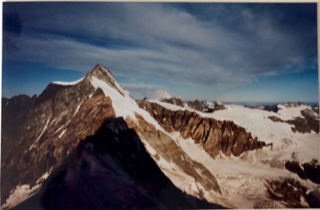
While the technical difficulties were not particularly high, in addition to the the undoubtedly strenuous effort for the long climbing, another concern of mine was the dizziness, shortness of breath and thirst deriving from the altitude.
I was very lucky in facing this demanding ascent: good weather, sun, no snow, very little verglas. In August the Lion Ridge is almost entirely free of snow, just with some on the crest of the Pic Tyndall and on the final crest which connects the Italian summit to the Swiss one. So there was no need for crampons that day.
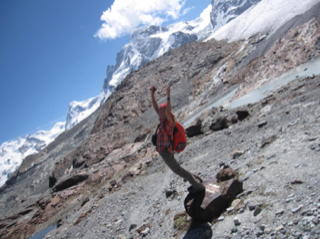
The Matterhorn: where different countries meet
Once on the summit I saw on my right in the distance, climbers from Switzerland who had just reached the top at the same time. On the Matterhorn the climbing days start, of course, from different countries, and the Matterhorn uniquely links us all in the common adventurous dream to be on its top.
I thought that no other cross on the top of a mountain was as unique as the cross on the Matterhorn, with the ancient names of the two villages Zermatt and Valtournenche – Pratumbor, the Latin name of Zermatt, and from the Italian side the word Vallistornench, the Latin name of Valtournenche. You need two arms to make the cross, and the 2 villages are symbolically united forever!
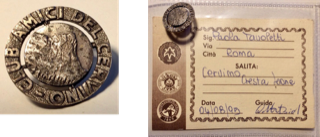
The descents & ascents : Not to be underestimated!
After eating some ham and fruits, we soon started the descent: it was treacherous. Some climbers fail just descending, in a series of “corda doppia“. For me the alpine guide has always been very important in mountaineering and in my opinion is an absolute necessity when climbing the Matterhorn. But I remember that day having met many climbers (mainly from abroad—Slovenia, Poland, France, and Spain) on their own without an alpine guide.
Incredibly, some were just wearing a sort of gym shoes. Every now and then they consulted a manual with the description of the numerous passages of the climbing. That day a couple had serious problems during the descent. Their rope became trapped among the rocks. Someone told us later on that at night they had not yet arrived at the Capanna.
The Lion Crest is a dangerous crest. I know that all the ascents to the Matterhorn are, and must not be undervalued even by expert climbers.
Full of granite
I particularly liked the physical contact of my hands and fingers with the rock and the beauty of those “handles” that the granite of the Matterhorn offers to the climber.
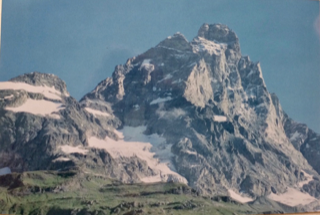
The granite of the Matterhorn is so interesting! I never much liked climbing on calcare, what is very typical of my Lazio region of Italy. Those holes eroded by water in calcare do not appeal to me as much as the long fissures on the granite rock of the Matterhorn. To me, the Matterhorn has many different personalities which derive not only from its different faces and richness of crests but also from the diversity of its rock types: gabbro, ortogneiss, and granite.
Along the descent I slid on the passage called the Lenzuolo, Linceul. The Linceul glacier is to be overcome with the help of fixed metal ropes. The terrain is inclined.
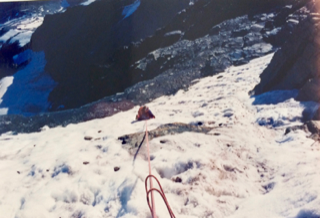
Tiredness on the descent
I had no problem at this passage when climbing up, but, on the descent, tiredness caused me – not being hooked to the metal cable – to slide down. Of course, I then had to climb back up using the rope held in the hands of my alpine guide.
The passages that I most liked are the “Pic Tyndall“, the “Scala Jordan“, and the “Enjambée“
“I jumped!”
From Pic Tyndall walking along the edge of the ridge one arrives at the Enjambée, a narrow and very steep carving that separates the Pic Tyndall from the upper part of the Matterhorn ridge. To overcome it, if you are not lucky enough to find it filled with snow, you need to jump! I jumped.

On the ascent, when I reached the Col Félicité, a small terrace, I found the series of fixed ropes to help the ascent. The most characteristic of these equipped passages is the Scala Jordan, a rope ladder with 25 sturdy wooden stepsthat allows the climber to go up a very exposed overhanging ten meter plate. Almost at the end of the ascent, lifting up the weight of my body and my little knapsack on the Scala Jordan seemed impossible in some moments .
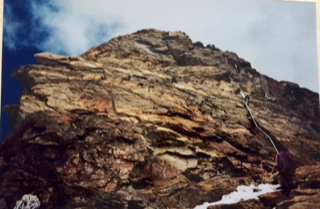
Differences now and then
When I climbed the Matterhorn that 4 August 1995 I could still witness the existence of the very old Capanna Carrel, now removed from the mountain and substituted with the new “Capanna”. The platform where the old Capanna Luigi Amedeo di Savoia was located collapsed in the summer of 2003 following a large landslide (the same one that caused the fall of the Cheminée). The old hut is itself now located in front of the Matterhorn Guide office in the Cervinia.
Moreover, on the day of my climb it was possible to climb the entire original Cheminée, a dihedral, a big fissure above the Placche Seiler. It collapsed in 2003 and is today substituted by a variant.
Many layers of Matterhorn art
As an artist I have dedicated some of my paintings to the Matterhorn. They have been exhibited in group exhibitions of mountain painters in Gavarnie, Pyrenees region, and in Briançon, France.
The technique I chose for these mountain paintings – many layers of oil and acrylic paints – seems appropriate for the mountain subject as mountain is itself made of many layers. As are the many layers of impressions and feelings that my ascent of the Matterhorn, my Cervino, has left impressed on my soul forever.
